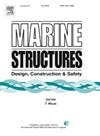VIV fatigue assessment by scaling of model test results
Abstract
Bending strain data from 3 well-instrumented VIV model test programs on simply supported bare pipes under uniform flow are processed using rainflow counting to get fatigue damage rates directly. These are presented in terms a dimensionless fatigue-equivalent bending strain amplitude, ϵe, which for the structurally undamped simply supported span under constant axial force N undergoing small rotations depends on 5 dimensionless parameters, and only weakly on the fatigue resistance curve used. Existing and new approximations are discussed as assessed whereby the number of dimensionless parameters that affect ϵe may be reduced from 5 to 1. Thus a scaling approach is developed, whereby any VIV test can be scaled to represent any prototype at a current velocity determined by the scaling procedure. The procedure uses scaling only for the dynamic part of the response, and structural analysis for the static part. It works for single as well as multi-mode response. It is illustrated for a 150m-long prototype span subject to high currents. The test and/or scaling results are also compared to predictions by existing methods, including DNVGL-RP-F105 (“F105”) and Vivana. The example also illustrates how the proposed method can be used for partially strake-covered (“straked”) pipes, provided the strake coverage is similar for model and prototype. The scatter in the data gives an indication of the uncertainties involved in estimating VIV fatigue damage rates from limited experimental data where high-mode and multi-mode response is possible.

 求助内容:
求助内容: 应助结果提醒方式:
应助结果提醒方式:


